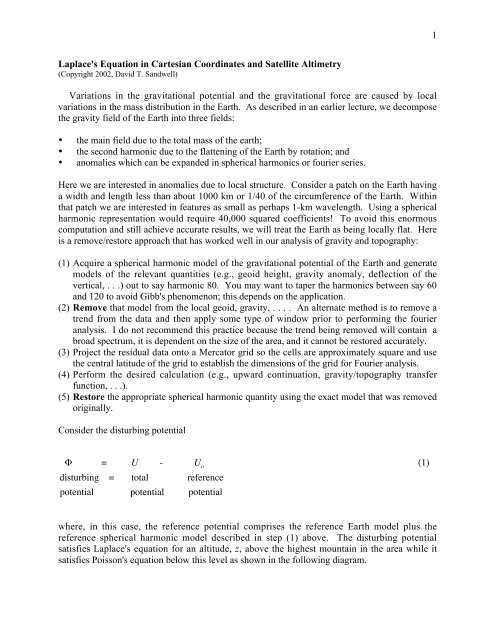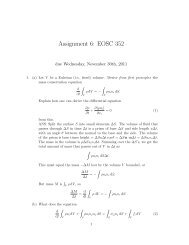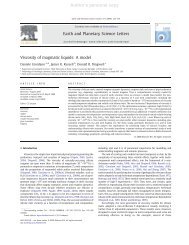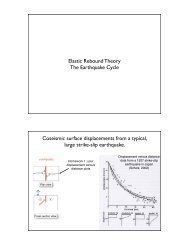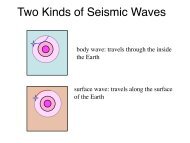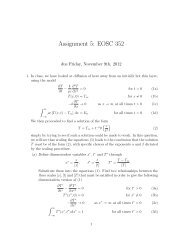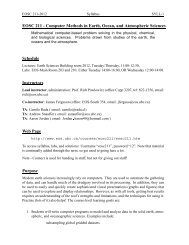1 Laplace's Equation in Cartesian Coordinates and Satellite ...
1 Laplace's Equation in Cartesian Coordinates and Satellite ...
1 Laplace's Equation in Cartesian Coordinates and Satellite ...
You also want an ePaper? Increase the reach of your titles
YUMPU automatically turns print PDFs into web optimized ePapers that Google loves.
1<strong>Laplace's</strong> <strong>Equation</strong> <strong>in</strong> <strong>Cartesian</strong> Coord<strong>in</strong>ates <strong>and</strong> <strong>Satellite</strong> Altimetry(Copyright 2002, David T. S<strong>and</strong>well)Variations <strong>in</strong> the gravitational potential <strong>and</strong> the gravitational force are caused by localvariations <strong>in</strong> the mass distribution <strong>in</strong> the Earth. As described <strong>in</strong> an earlier lecture, we decomposethe gravity field of the Earth <strong>in</strong>to three fields:• the ma<strong>in</strong> field due to the total mass of the earth;• the second harmonic due to the flatten<strong>in</strong>g of the Earth by rotation; <strong>and</strong>• anomalies which can be exp<strong>and</strong>ed <strong>in</strong> spherical harmonics or fourier series.Here we are <strong>in</strong>terested <strong>in</strong> anomalies due to local structure. Consider a patch on the Earth hav<strong>in</strong>ga width <strong>and</strong> length less than about 1000 km or 1/40 of the circumference of the Earth. With<strong>in</strong>that patch we are <strong>in</strong>terested <strong>in</strong> features as small as perhaps 1-km wavelength. Us<strong>in</strong>g a sphericalharmonic representation would require 40,000 squared coefficients! To avoid this enormouscomputation <strong>and</strong> still achieve accurate results, we will treat the Earth as be<strong>in</strong>g locally flat. Hereis a remove/restore approach that has worked well <strong>in</strong> our analysis of gravity <strong>and</strong> topography:(1) Acquire a spherical harmonic model of the gravitational potential of the Earth <strong>and</strong> generatemodels of the relevant quantities (e.g., geoid height, gravity anomaly, deflection of thevertical, . . .) out to say harmonic 80. You may want to taper the harmonics between say 60<strong>and</strong> 120 to avoid Gibb's phenomenon; this depends on the application.(2) Remove that model from the local geoid, gravity, . . . . An alternate method is to remove atrend from the data <strong>and</strong> then apply some type of w<strong>in</strong>dow prior to perform<strong>in</strong>g the fourieranalysis. I do not recommend this practice because the trend be<strong>in</strong>g removed will conta<strong>in</strong> abroad spectrum, it is dependent on the size of the area, <strong>and</strong> it cannot be restored accurately.(3) Project the residual data onto a Mercator grid so the cells are approximately square <strong>and</strong> usethe central latitude of the grid to establish the dimensions of the grid for Fourier analysis.(4) Perform the desired calculation (e.g., upward cont<strong>in</strong>uation, gravity/topography transferfunction, . . .).(5) Restore the appropriate spherical harmonic quantity us<strong>in</strong>g the exact model that was removedorig<strong>in</strong>ally.Consider the disturb<strong>in</strong>g potentialΦ = U - U o(1)disturb<strong>in</strong>g = total referencepotential potential potentialwhere, <strong>in</strong> this case, the reference potential comprises the reference Earth model plus thereference spherical harmonic model described <strong>in</strong> step (1) above. The disturb<strong>in</strong>g potentialsatisfies <strong>Laplace's</strong> equation for an altitude, z, above the highest mounta<strong>in</strong> <strong>in</strong> the area while itsatisfies Poisson's equation below this level as shown <strong>in</strong> the follow<strong>in</strong>g diagram.
z2∆ 2 Φ = 0yair∆ 2 Φ = -4πGρrockxΦ(x,y,z) -- disturb<strong>in</strong>g potential (total - reference)G -- gravitational constantρ -- density anomaly (total - reference)<strong>Laplace's</strong> equation is a second order partial differential equation <strong>in</strong> three dimensions.2 2 2∂ Φ ∂ Φ ∂ Φ+ + = 0, z > 0 (2)2 2 2∂x ∂y ∂zSix boundary conditions are needed to develop a unique solution. Far from the region, thedisturb<strong>in</strong>g potential must go to zero; this accounts for 5 of the boundary conditionslim Φ= 0, lim Φ= 0, lim Φ= 0 (3)x →∞ y →∞ z→∞At the surface of the earth (or at some elevation), one must either prescribe the potential or thevertical derivative of the potential.Φ( xy , , 0) = Φ ( xy , ) - - Dirichleto∂Φ∂z= −∆gxy( , ) - - Neumann (4)To solve this differential equation, we'll use the 2-D fourier transform aga<strong>in</strong> where the forward<strong>and</strong> <strong>in</strong>verse transform are∞ ∞∫ ∫−i2π( kx ⋅ ) 2F(k) = f( x)e d x (5)−∞ −∞∞ ∞∫ ∫i2π( kx ⋅ ) 2f(x) = F( k)e d k−∞ −∞
4The upward cont<strong>in</strong>uation physics is the same for the potential <strong>and</strong> all of its derivatives. Forexample, if one measured gravity anomaly at the surface of the earth ∆g(x,0), then to computethe gravity at an altitude of z, one takes the fourier transform of the surface gravity, multiplies bythe upward cont<strong>in</strong>uation kernel, <strong>and</strong> <strong>in</strong>verse transforms the result. This exponential decay of thesignal with altitude is a fundamental barrier to recovery of small-scale gravity anomalies from ameasurement made at altitude. Here are two important examples.i) Mar<strong>in</strong>e gravity - Consider mak<strong>in</strong>g mar<strong>in</strong>e gravity measurement on a ship which is 4 km abovethe topography of the ocean floor. (Most of the short-wavelength gravity anomalies aregenerated by the mass variations associated with the topography of the seafloor.) At awavelength of say 8 km, the ocean surface anomaly will be attenuated by 0.043 from theamplitude of the seafloor anomaly.ii) <strong>Satellite</strong> gravity - The typical altitude of an artificial satellite used to sense variations <strong>in</strong> thegravity field is 400 km so an anomaly hav<strong>in</strong>g a 100-km wavelength will be attenuated by a factorof 10 -11 ! This is why radar altimetry (below), which measures the geoid height directly on theocean surface topography is so valuable.Derivatives of the gravitational potentialThis solution to <strong>Laplace's</strong> equation can be used to construct all of the common derivatives ofthe potential. Suppose one has a complete survey over a patch on the surface of the earth so afourier method can be used to convert among the different representations of the gravity field.This is particularly true for comput<strong>in</strong>g gravity anomaly from geoid height or deflection of thevertical. The general relation between the potential <strong>in</strong> the space doma<strong>in</strong> (at any altitude) <strong>and</strong> thefourier transform of the surface potential is.∞ ∞− k z i ( ⋅ )Φ( x, z) = ∫ ∫ Φ( k,0)e 2 π kxe 2 πd2 k−∞ −∞The follow<strong>in</strong>g table uses equation (10) <strong>and</strong> the def<strong>in</strong>itions of the derivatives of the potential toconstruct the variety of anomalies. Before exam<strong>in</strong><strong>in</strong>g these relationships however, lets reviewsome of the def<strong>in</strong>itions <strong>in</strong> relation to what can be measured.(10)Gravitational potentialFirst derivative of potentialN - geoid height - S<strong>in</strong>ce the ocean surface is an equipotentialsurface, variations <strong>in</strong> gravitational potential will produce variations<strong>in</strong> the sea surface height. This can be measured by a radaraltimeter.∆g - gravity anomaly - This is the derivative of the potential withrespect to z. It can be measured by an accelerometer such as agravity meter.η, ξ - deflection of the vertical - These are the derivatives of thepotential with respect to x <strong>and</strong> y, respectively. These are also
5forces, however, they are usually measured by record<strong>in</strong>g the t<strong>in</strong>yangle between a plumb bob <strong>and</strong> the vector po<strong>in</strong>t<strong>in</strong>g to the center ofthe earth. Over the ocean this is most easily measured by tak<strong>in</strong>gthe along-track derivative of radar altimeter profiles.2 2 2⎡∂Φ ∂ Φ ∂ Φ ⎤⎢ 2∂x ∂∂ x y ∂∂ x z⎥⎢22 ⎥∂ Φ ∂ ΦSecond derivative of potential- ⎢⎥- gravity gradient - This is a symmetric2⎢ ∂y∂∂ y z ⎥⎢2∂ Φ ⎥⎢⎥2⎣⎢∂z⎦⎥tensor of second partial derivatives of the gravitational potential.A direct way of mak<strong>in</strong>g this measurement is to construct a set ofaccelerometers each spaced at a distance of ∆ <strong>in</strong> the x, y, <strong>and</strong> zdirections. What is the m<strong>in</strong>imum number of accelerometersneeded to measure the full gravity gradient tensor? What can yousay about the trace of this tensor when the measurements are made<strong>in</strong> free space? Below we'll develop an alternate method ofmeasur<strong>in</strong>g ∂ 2Φover the ocean us<strong>in</strong>g a radar altimeter.2∂zTable 1. Relationships among the various representations of the gravity field <strong>in</strong> free space.space doma<strong>in</strong>wavenumber doma<strong>in</strong>geoid height from thepotentialN( x) ≅ 1 Φ( x, 0)N( k) ≅ 1 Φ ( k, 0)(11)gggravity anomaly from thepotentialdeflection of the verticalfrom the potential (east slope<strong>and</strong> north slope)Φ∆g( x, z) ≅− ∂ ( x, z)∂z∂N1 ∂Φη( x)=− ≅−∂x g ∂x∂N1 ∂Φξ( x)=− ≅−∂y g ∂y−2πz∆g( k, z) ≅ 2πkekΦ( k, 0)i2πkxη( k) ≅− Φ( k, 0)gi2πkyξ( k) ≅− Φ( k, 0)g(12)(13)gravity anomaly fromdeflection of the vertical[Haxby et al., 1983][ ]ig∆g( k) = kxη( k) + kyξ ( k)(14)kvertical gravity gradientfrom the curvature of theocean surface2 2∂g⎛ ∂ N ∂ N ⎞= g⎜+ ⎟ (15)2 2∂z⎝ ∂x∂y⎠
6As an exercise, use <strong>Laplace's</strong> equation <strong>and</strong> the various def<strong>in</strong>itions to develop gravity anomalyfrom vertical deflection (equation 14) <strong>and</strong> vertical gravity gradient from ocean surface curvature(equation 15).Here is a practical example. Suppose one has measurements of geoid height N(x)over a largearea on the surface of the ocean <strong>and</strong> we wish to calculate the gravity anomaly, ∆g(x,z) at altitude.The prescription is:(1) remove an appropriate spherical harmonic model from the geoid;(2) take the 2-D fourier transform of Ν(x);−2πk(3) multiply by g2πk e ;(4) take <strong>in</strong>verse 2-D fourier transform;(5) restore the match<strong>in</strong>g gravity anomaly calculated from the spherical harmonic model ataltitude.Conversion of geoid height to vertical deflection, gravity anomaly, <strong>and</strong> vertical gravitygradient from satellite altimeter profilesAs described above, geoid height N(x) <strong>and</strong> other measurable quantities such as gravityanomaly g(x) are related to the anomalous gravitational potential Φ(x,z) through <strong>Laplace's</strong>equation. It is <strong>in</strong>structive to go through an example of how measurements of ocean surfacetopography from satellite altimetry can be used to construct geoid height, deflection of thevertical, gravity anomaly, <strong>and</strong> vertical gravity gradient.The surface of the ocean is displaced both above <strong>and</strong> below the reference ellipsoidal shape ofthe Earth (Figure 2). These differences <strong>in</strong> height arise from variations <strong>in</strong> gravitational potential(i.e., geoid height) <strong>and</strong> oceanographic effects (tides, large-scale currents, el N<strong>in</strong>o, eddies, . . .).Fortunately, the oceanographic effects are small compared with the permanent gravitationaleffects so a radar altimeter can be used to measure these bumps <strong>and</strong> dips. At wavelengths lessthan about 200 km, bumps an dips <strong>in</strong> the ocean surface topography reflect the topography of theocean floor <strong>and</strong> can be used to estimate seafloor topography <strong>in</strong> areas of sparse ship coverage.Radar altimeters are used to measure the height of the ocean surface above the referenceellipsoid (i.e., the satellite above the ellipsoid H * m<strong>in</strong>us the altitude above the ocean surface H).A GPS, or ground-based track<strong>in</strong>g system, is used to establish the position of the radar H * (as afunction of time) to an accuracy of better than 0.1 m. The radar emits 1000 pulses per second atKu-b<strong>and</strong>. These spherical wave fronts reflect from the closest ocean surface (nadir) <strong>and</strong> return tothe satellite where the two-way travel times is recorded to an accuracy of 3 nanoseconds (1-mrange variations mostly due to ocean waves). Averag<strong>in</strong>g thous<strong>and</strong>s of pulses reduces the noise toabout 30 mm. If one is <strong>in</strong>terested <strong>in</strong> mak<strong>in</strong>g an accurate geoid height map such, as shown <strong>in</strong>Figure 4, then many sources of error must be considered <strong>and</strong> somehow removed. However, ifthe f<strong>in</strong>al product of <strong>in</strong>terest is one of the derivatives of the potential then it is best to take the
7along-track derivative of each profile to develop along-track sea surface slope. In this case, thepo<strong>in</strong>t-to-po<strong>in</strong>t precision of the measurements is the limit<strong>in</strong>g factor.Figure 2. Schematic diagram of a radar altimeter orbit<strong>in</strong>g the earth at an altitude of 800 km.
8Figure 3. Ground tracks for two radar altimeters that have provided adequate coverage of the oceansurface. This is a 1500-km by 1000-km area around Hawaii. Geosat/ERM (US Navy) is the exact repeatorbit phase of the Geosat altimeter mission (US Navy, 1985-89). These ground tracks repeat every 17days to monitor small changes <strong>in</strong> ocean surface height caused by time-vary<strong>in</strong>g oceanographic effects.Geosat/GM ground tracks were acquired dur<strong>in</strong>g a 1.5-year period when the orbit was allowed to drift.Similarly ERS/GM was a European Space Agency phase of the ERS mission that acquired non-repeatprofiles for 1 year. ERS/ERM is the 35-day repeat phase of the ERS mission.Figure 4. Geoid height above the WGS84 ellipsoid <strong>in</strong> meters (5-m contour <strong>in</strong>terval) derived fromaltimeter profiles <strong>in</strong> Figure 3. The geoid height is dom<strong>in</strong>ated by long-wavelengths so it is difficult toobserve the small-scale features caused by ocean-floor topography. These can be enhanced by comput<strong>in</strong>geither the horizontal derivative (ocean surface slope) or the vertical derivative ( gravity anomaly).To avoid a crossover adjustment of the data, ascend<strong>in</strong>g <strong>and</strong> descend<strong>in</strong>g satellite altimeterprofiles are first differentiated <strong>in</strong> the along-track direction result<strong>in</strong>g <strong>in</strong> geoid slopes or alongtrackvertical deflections. These along-track slopes are then comb<strong>in</strong>ed to produce east η <strong>and</strong>north ξ components of vertical deflection [S<strong>and</strong>well, 1984]. F<strong>in</strong>ally the east <strong>and</strong> north verticaldeflections are used to compute both gravity anomaly <strong>and</strong> vertical gravity gradient. Thealgorithm used for gridd<strong>in</strong>g the altimeter profiles is an iteration scheme that relies on rapidtransformation from ascend<strong>in</strong>g/descend<strong>in</strong>g geoid slopes to north/east vertical deflection <strong>and</strong> viceversa. The details for convert<strong>in</strong>g along-track slope <strong>in</strong>to east <strong>and</strong> north components of deflectionof the vertical are provided <strong>in</strong> the Appendix <strong>and</strong> also <strong>in</strong> a reference [S<strong>and</strong>well <strong>and</strong> Smith, 1997].You probably don't need to know these details unless you plan to do research <strong>in</strong> mar<strong>in</strong>e gravity.
9Figure 5. East component of sea surface slope η(x) derived from Geosat <strong>and</strong> ERS altimeter profiles. Notethis component is rather noisy because the altimeter tracks (Figure 3) run ma<strong>in</strong>ly <strong>in</strong> a N-S direction.Figure 6. North component of sea surface slope ξ(x) derived from Geosat <strong>and</strong> ERS altimeter profiles.Note this component has lower noise because the altimeter tracks (Figure 3) run ma<strong>in</strong>ly <strong>in</strong> a N-Sdirection.To compute gravity anomaly (Figure 7) from a dense network of satellite altimeter profiles ofgeoid height (Figure 2), one constructs grids of east η <strong>and</strong> north ξ vertical deflection (Figures 5<strong>and</strong> 6). The grids are then Fourier transformed <strong>and</strong> Eq. (5) is used to compute gravity anomaly.At this po<strong>in</strong>t one can add the long wavelength gravity field from the spherical harmonic model to
10the gridded gravity values <strong>in</strong> order to recover the total field; the result<strong>in</strong>g sum may be comparedwith gravity measurements made on board ships. A more complete description of gravity fieldrecovery from satellite altimetry can be found <strong>in</strong> [Hwang <strong>and</strong> Parsons, 1996; S<strong>and</strong>well <strong>and</strong>Smith, 1997; Rapp <strong>and</strong> Yi, 1997].Figure 7. Gravity anomaly ∆g(x) derived from east <strong>and</strong> north components of sea surface slope us<strong>in</strong>gequation (14). (50 mGal contour <strong>in</strong>terval)Figure 8. Vertical gravity gradient dg(x)/δz derived from east <strong>and</strong> north components of sea surface slopeus<strong>in</strong>g equation (15). Note this second derivative of the geoid amplifies the shortest wavelengths; comparewith the orig<strong>in</strong>al geoid (Figure 3). Noise <strong>in</strong> the altimeter measurements has been amplified result<strong>in</strong>g <strong>in</strong> anartificial texture. (100 Eotvos contour <strong>in</strong>terval)
11There is an important issue for construct<strong>in</strong>g gravity anomaly from sea surface slope that isrevealed by a simplified version of equation (14). Consider the sea surface slope <strong>and</strong> gravityanomaly across a two-dimensional structure which depends on x but not y. The y-component ofslope is zero so conversion from sea surface slope to gravity anomaly is simply a Hilberttransform:∆g( k) igsgn( k)η k(16)= ( )x x xNow it is clear that one µrad of sea surface slope maps <strong>in</strong>to 0.98 mGal of gravity anomaly <strong>and</strong>similarly one µrad of slope error will map <strong>in</strong>to ~1 mGal of gravity anomaly error. Thus theaccuracy of the gravity field recovery is controlled by the accuracy of the sea surface slopemeasurement.APPENDIX - Vertical Deflections from Along-Track SlopesConsider for the moment the <strong>in</strong>tersection po<strong>in</strong>t of an ascend<strong>in</strong>g <strong>and</strong> a descend<strong>in</strong>g satellitealtimeter profile. The derivative of the geoid height N with respect to time t along the ascend<strong>in</strong>gprofile isN a ≡ ∂Na∂t<strong>and</strong> along the descend<strong>in</strong>g profile is= ∂N θ a + ∂N φ a∂θ ∂φ(B1)N d = ∂N∂θ θ d + ∂N∂φ φ d(B2)where is θ geodetic latitude <strong>and</strong> φ is longitude. The functions θ <strong>and</strong> φ are the latitud<strong>in</strong>al <strong>and</strong>longitud<strong>in</strong>al components of the satellite ground track velocity. It is assumed that the satellitealtimeter has a nearly circular orbit so that its velocity depends ma<strong>in</strong>ly on latitude; at thecrossover po<strong>in</strong>t the follow<strong>in</strong>g relationships are accurate to better than 0.1%.θ a = -θ d φ a = φ d (B3)The geoid gradient (deflection of the vertical) is obta<strong>in</strong>ed by solv<strong>in</strong>g (B1) <strong>and</strong> (B2) us<strong>in</strong>g (B3).
12∂N= 1 ∂φ 2φ∂N∂θ = 12θNa + N dNa - N d(B4)(B5)It is evident from this formulation that there are latitudes where either the east or northcomponent of geoid slope may be poorly determ<strong>in</strong>ed. For example, at ±72˚ latitude, the Seasat<strong>and</strong> Geosat altimeters reach their turn<strong>in</strong>g po<strong>in</strong>ts where the latitud<strong>in</strong>al velocity θ goes to zero <strong>and</strong>thus (B4) becomes s<strong>in</strong>gular. In the absence of noise this is not a problem because the ascend<strong>in</strong>g<strong>and</strong> descend<strong>in</strong>g profiles are nearly parallel so that their difference goes to zero at the same ratethat the latitud<strong>in</strong>al velocity goes to zero. Of course <strong>in</strong> practice altimeter profiles conta<strong>in</strong> noise, sothat the north component of geoid slope will have a signal to noise ratio that decreases near ±72˚latitude. Similarly for an altimeter <strong>in</strong> a near polar orbit, the ascend<strong>in</strong>g <strong>and</strong> descend<strong>in</strong>g profilesare nearly anti-parallel at the low latitudes; the east component of geoid slope is poorlydeterm<strong>in</strong>ed <strong>and</strong> the north component is well determ<strong>in</strong>ed. The optimal situation occurs when thetracks are nearly perpendicular so that the east <strong>and</strong> north components of geoid slope have thesame signal to noise ratio.When two or more satellites with different orbital <strong>in</strong>cl<strong>in</strong>ations are available, the situation isslightly more complex but also more stable. Consider the <strong>in</strong>tersection of 4 passes as shown <strong>in</strong>the follow<strong>in</strong>g diagram.2 41 3The along-track derivative of each pass can be computed from the geoid gradient at the crossoverpo<strong>in</strong>t
13N 1θ 1 φ 1∂NN 2=N 3N 4θ 2 φ 2θ 3 φ 3θ 4 φ 4∂θ∂N∂φ(B6)or <strong>in</strong> matrix notationN = Θ ∇N(B7)S<strong>in</strong>ce this is an overdeterm<strong>in</strong>ed system, the 4 along-track slope measurements cannot be matchedexactly unless the measurements are error-free. In addition, an a-priori estimate of the error <strong>in</strong>the along-track slope σ i measurements can be used to weight each equation <strong>in</strong> (B6) (i.e. divideeach of the four equations by σ i ). The least squares solution to (B7) is∇N = Θ t Θ -1 Θ t N(B8)where t <strong>and</strong> -1 are the transpose <strong>and</strong> <strong>in</strong>verse operations, respectively. In this case a 2 by 4system must be solved at each crossover po<strong>in</strong>t although the method is easily extended to three ormore satellites. Later we will assume that every grid cell corresponds to a crossover po<strong>in</strong>t of allthe satellites considered so this small system must be solved many times.In addition to the estimates of geoid gradient, the covariances of these estimates are alsoobta<strong>in</strong>ed2σ θθ2σ φθ2σ θφ2σ φφ= (Θ t Θ) -1 (B9)S<strong>in</strong>ce Geosat <strong>and</strong> ERS-1 are high <strong>in</strong>cl<strong>in</strong>ation satellites, the estimated uncerta<strong>in</strong>ty of the eastcomponent is about 3 times greater than the estimated uncerta<strong>in</strong>ty of the north component at theequator. At higher latitudes of 60˚-70˚ where the tracks are nearly perpendicular, the north <strong>and</strong>east components are equally well determ<strong>in</strong>ed. At 72˚ north where the Geosat tracks run <strong>in</strong> awesterly direction, the uncerta<strong>in</strong>ty of the east component is low <strong>and</strong> the higher <strong>in</strong>cl<strong>in</strong>ation ERS-1tracks prevent the estimate of the north component from becom<strong>in</strong>g s<strong>in</strong>gular at 72˚.F<strong>in</strong>ally, the east η <strong>and</strong> north ξ components of vertical deflection are related to the two geoidslopes by
14η = - 1 ∂Na cos θ ∂φ(B10)where a is the mean radius of the earth.ξ = - 1 a∂N∂θ(B11)REFERENCESHaxby, W. F., Karner, G. D., LaBrecque, J. L., <strong>and</strong> Weissel, J. K. (1983). Digital images ofcomb<strong>in</strong>ed oceanic <strong>and</strong> cont<strong>in</strong>ental data sets <strong>and</strong> their use <strong>in</strong> tectonic studies. EOS Trans.Amer. Geophys. Un. 64, 995-1004.Hwang, C., <strong>and</strong> Parsons, B. (1996). An optimal procedure for deriv<strong>in</strong>g mar<strong>in</strong>e gravity frommulti-satellite altimetry. J. Geophys. Int. 125, 705-719.Rapp, R. H., <strong>and</strong> Yi, Y. (1997). Role of ocean variability <strong>and</strong> dynamic topography <strong>in</strong> therecovery of the mean sea surface <strong>and</strong> gravity anomalies from satellite altimeter data. J.Geodesy 71, 617-629.S<strong>and</strong>well, D. T. (1984). A detailed view of the South Pacific from satellite altimetry. J.Geophys. Res. 89, 1089-1104.S<strong>and</strong>well, D. T., <strong>and</strong> Smith, W. H. F. (1997). Mar<strong>in</strong>e gravity anomaly from Geosat <strong>and</strong> ERS-1satellite altimetry. J. Geophys. Res. 102, 10,039-10,054.Yale, M. M., D. T. S<strong>and</strong>well, <strong>and</strong> W. H. F. Smith, Comparison of along-track resolution ofstacked Geosat, ERS-1 <strong>and</strong> TOPEX satellite altimeters, J. Geophys. Res., 100, p. 15117-15127, 1995.


